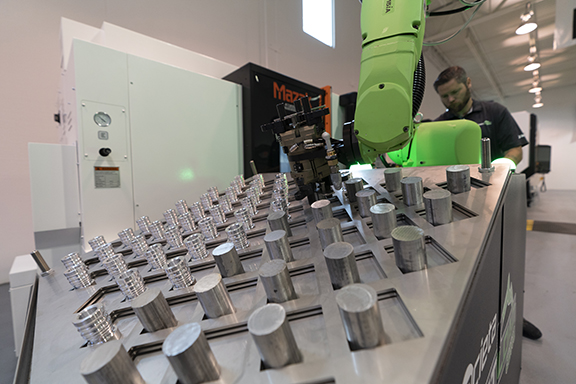
It’s common knowledge that robots in manufacturing lower costs and improve quality. Businesses become more competitive and are able to grow, sometimes re-shoring manufacturing in the process. However, it is a fallacy that robots take away human jobs. Rather than cutting headcounts, companies using robots find they need more people to handle the increased volumes. In short, robots create a virtuous circle of investment, growth and job creation.
Jobs for Robots
When people have to complete repetitive manual tasks — especially those needing precision — they get tired, make mistakes and are susceptible to getting injured. Human quality is inconsistent and output suffers.
Dull, difficult and dangerous jobs are found in industries from food processing to electronics and aerospace. Many are candidates for switching to robotic automation. That is why robots are working in foundries, tending stamping presses and molding machines, and deflashing castings. They're picking parts from moving conveyors, assembling complex products and making consistent welds.
At the end of production lines, robots pack parts in cartons and place those cartons on pallets. Thanks to the latest robotic innovations, they're even handling irregular packages and building mixed pallets that simplify distribution.
Implementation Barriers Falling
Some small and medium businesses have reservations about using robots in manufacturing. They worry about needing specialist skills, having the flexibility for short production runs, and the cost of implementation.
These were valid concerns a decade or more ago, but technology has advanced, and the skills base has grown. Today's industrial robots are easy to program — both at the machine and in the office. Powerful software packages enable fast and accurate offline programming, minimizing on-machine program touch-up. Many users assign programming to maintenance technicians rather than hiring special programming staff.
Robots can be more flexible through adjustable cell and gripper design. Integrators with many successful projects behind them know what works best for operations with different products and applications. Experienced integrators understand the particular challenges of a first robot implementation and can deliver training and support to ensure project success.
Robotic Innovations Lead to New Applications
Three technologies — vision systems, collaborative robots and forcing sensing — are improving robot versatility while lowering implementation costs.
Collaborative Robots, (cobots) replace expensive, space-consuming guards with power- and force-limiting designs and advanced sensor technology. This lets robots work alongside and in partnership with human workers. The worker focuses on those parts of the job needing analysis and judgment, while the unskilled and repetitive jobs are left for the robot.
Force sensing gives robots a crude sense of touch. In assembly work, if one part is not fitting against another, the robot can back off, re-orient the part, and try again.
Robots Create New Jobs
Robots complement people. Not only must humans build, sell and ship robots, but they need to design and build cells and program and maintain the machines. All this means more jobs for programmers, controls specialists, systems integrators, tool designers and component manufacturers.
Lower costs and higher quality almost invariably result in higher profitability, and manufacturers may respond by increasing job capacity. That may mean more machines, but often also requires human skills like creative problem solving, design and ingenuity.
Consumers benefit from lower prices, which has the potential to increase spending and stimulate more manufacturing.
The message is clear: robots create a positive circle of investment, growth and job creation.